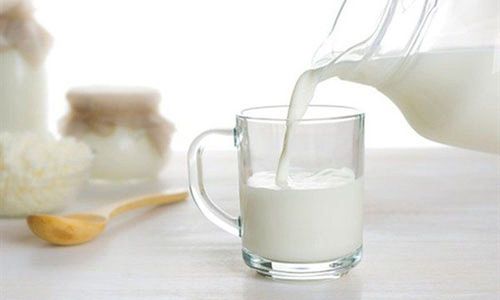This is an automatically translated article.
The article is professionally consulted by Master, Doctor Huynh Bao Toan - Department of Pediatrics - Neonatology - Vinmec Nha Trang International General Hospital.
Breast milk is the most perfect natural food for babies and children. However, for some reasons such as the mother does not have milk, the sick mother has to be isolated from the child, the mother has to take special medicine... some children are not breastfed completely. Therefore, infant formula, also known as "formula," will have to supplement or replace breast milk.
1. What is formula milk?
Formula milk (also known as Baby formula) or infant formula, is manufactured to be used as food for infants and children under 12 months of age. Formula milk has a similar chemical composition to breast milk, so it can be used as a complete or partial replacement for breast milk.There are 3 types of formula: ready-to-drink, condensed milk and powdered milk.
Pre-mixed formula is definitely the most convenient. Mothers do not need to measure or mix anything, just open the lid and let the baby drink immediately. This milk ensures hygiene and is especially convenient when parents do not know where to find water to make milk. The price of ready-made milk is usually about 20% more expensive than powdered milk. Milk cartons also take up more space in the cabinet and in the family's trash can. Ready-to-drink milk only keeps for about 48 hours after opening. And this milk also has a slightly darker color than powdered milk, so it is easy to leave stains on children's clothes. For concentrated formula, the mother needs to mix it with water. The ratio of milk and water is usually 1:1, but always remember to read the instructions on the box carefully. Compared to ready-made, condensed milk is cheaper and less bulky. However, this form of milk is still more expensive than powdered milk. Powdered milk is the most economical and eco-friendly option, taking up less space in transport and in the household cupboards and trash cans.

Trắc nghiệm: Sự phát triển tinh thần, vận động của bé thế nào là đúng chuẩn?
Khi nào bé biết nói, biết hóng chuyện hay biết cầm cốc là "đúng chuẩn"? Điểm xem bạn biết được bao nhiêu mốc phát triển tinh thần, vận động "đúng chuẩn" của bé nhé!The following content is prepared under supervision of Thạc sĩ, Bác sĩ y khoa, Ma Văn Thấm , Nhi , Phòng khám Đa khoa Quốc tế Vinmec Dương Đông(Phú Quốc)
2. Criteria for choosing powdered milk
Nutritionists recommend that mothers choose formula milk for their babies according to the following specific criteria: Suitable for the baby's age and weight; suitable for the baby's health status (premature birth, full term, low birth weight, malnutrition, obesity ..); the baby's allergic status (monitoring after drinking to see if the baby has acne, diarrhea, constipation?), milk price in accordance with family economic conditions...Pay special attention to the rate Is the proportion of protein in milk ingredients appropriate for the age of the child? To know this, mothers can base themselves on the following standards:
Children aged 0-12 months, the standard protein ratio is about 11-18%; From 12-36 months old, the protein ratio is 18-34%. If the percentage of protein in milk is too low, it will make the child malnourished, the risk of infection is high, and the immune system is weak. On the contrary, if too much protein will lead to hormone disorders, poor nervous system development, obesity and cardiovascular disease.
In addition to the criterion of protein ratio, mothers also need to pay attention to other nutrients found in milk such as DHA, ARA, Beta-Glucan... which support the immune system and brain development in children.
Note on milk color: Quality powdered milk, guaranteed to be genuine, has a light yellow color, bright, pleasant aroma, slightly sweet taste when tasted. As for the color is a bit dark, the smell is unpleasant or the taste is strange, you need to be hesitant.
Should only give the baby milk for 2 consecutive months to check if the baby is allergic and suitable for milk, then decide to continue using or change another more suitable milk.

3. How to choose baby formula
Deciding which formula to use is appropriate for mothers based on the following criteria: Child's health, age, nutritional needs, and price.
3.1. Milk for children under 1 year old
a) Milk for premature babies with low birth weightMilk containing high protein, vitamins and minerals is suitable for premature babies. Milk has a higher energy ratio than normal milk (0.7-0.75Kcal/ml vs 0.67Kcal/ml). In addition, in developed countries, there are canned breast milk with added micronutrients such as Enfamil Human Milk Fortifier, Similac Natural Care Human Milk Fortifier, Similac Human Milk Fortifier...
b) Formula milk Use for children under 6 months old
This type of milk is suitable for babies (with birth weight over 2500g) to 6 months old because it is easy to digest and has a calcium/phosphorus ratio = 2:1, this ratio is optimal. It is beneficial for the kidneys of young children and enhances calcium absorption. Milk provides adequate nutrients when the child is fed 150ml/kg body weight/day.
c) Milk for children from 6 months to 12 months old
Children after 6 months of age need to be given a variety of complementary foods with all 4 food groups including fat, starch, protein, vegetables and fruits. The baby's weight gain will no longer depend as much on the milk diet as children under 6 months old. Children only need to drink 500-800ml of milk/day, depending on the current weight of the child.
3.2. Milk for children over 1 year old
For example, Dutch Girl 123, Enfagrow, Dielac3, Dugro, Nestlé 1+...Can be divided into over 3 years old and over 6 years old because depending on the priority needs of nutrients by age, such as more calcium There are many substances that strengthen the fight against infection, but in general they are relatively unchanged and the choice does not need to be too strict because children also eat a variety of other foods. Children need to drink about 300-500ml of milk per day.3.3. Milk group for special needs
Lactose-free groupThis milk group is often used for children with irritable bowels, bloating, and loose stools due to lactose sensitivity. Based on the protein source in milk, this group is divided into 2 types:
Animal origin: eg Dumex lacto-free, Similac Lactose Free, Enfalac Lactose Free ... Plant origin: eg Prosobee , Nursoy, Isomil.... Hydrolyzed Milk
Lactose-free milk and hydrolyzed cow's milk protein make it easy to digest for children with cow's milk allergy such as: Nutramigen, Pregestimil and Alimentum. In addition, it can be used for children from birth with digestive disorders, diarrhea of any kind, food intolerance due to prolonged severe diarrhea, multiple bowel resections, malnutrition. Therefore, if there is a family history of food allergies or children are allergic to cow's milk, mothers should choose soy milk or hydrolyzed milk if the child is not breastfed. However, some children with a cow's milk allergy have a cross-allergic reaction to soy milk.
Milk for babies with GERD
Some formulas with added rice starch (eg Enfamil AR), or added natural gum with milk thickening properties to help reduce vomiting regurgitates and nourishes beneficial bacteria in the intestines, increases stool volume and consistency, prevents constipation and spasms (eg Frisolac Comfort).
Fat-free milk group
Fat-free milk will contain less energy and no cholesterol is often used for those who need calcium but do not want to gain weight or need to abstain from fat as in lipid metabolism disorders , high cholesterol, diabetes or fat malabsorption such as hepatobiliary disease, digestive
4. Notes when mixing infant formula
After deciding to choose the type of milk for the baby, the mother also needs to pay special attention to the following issues:See the shelf life on the milk label. Prepare milk according to the instructions on the package because if the mother mixes too much, it can lead to electrolyte disturbances and damage the kidneys of the baby. On the contrary, if it is too diluted, it will affect the nutrition, growth and weight of children. Hands should be washed before handling the bottle and when feeding the baby. Bottles should always be sterilized before feeding your baby. After the baby has finished breastfeeding, the leftover milk should be discarded because the bacteria in the baby's saliva will grow in the leftover milk. It should be noted that milk should not be pre-mixed in the refrigerator, but should be heated when eating that meal for the baby. Avoid using the microwave to warm baby formula because the temperature inside can be hotter than you think. Absolutely do not use bone broth or vegetable broth to make milk for children to drink. For children to be healthy and develop well, it is necessary to have a nutritious diet in terms of quantity and quality balance. If children are not provided with adequate and balanced nutrients, it will lead to diseases of excess or lack of nutrients, which adversely affect the comprehensive development of children in terms of physical, mental and motor skills.
The period of baby eating solid foods is an extremely important period to help children develop comprehensively. Children who do not eat properly are at risk of micro-mineral deficiencies, causing anorexia, growth retardation, malabsorption, etc. If they notice the above signs, parents should supplement their children with supportive products. The supplement contains lysine, essential micro-minerals and vitamins such as zinc, chromium, selenium, and B vitamins to help fully meet the nutritional needs of children. At the same time, these essential vitamins also support digestion, enhance nutrient absorption, help improve anorexia, and help children eat well.
Parents can learn more:
Signs of zinc deficiency in children
Micronutrient deficiency and failure to gain weight in children
Please regularly visit Vinmec.com website and update useful information to take care of your child. Take care of the baby and the whole family.















